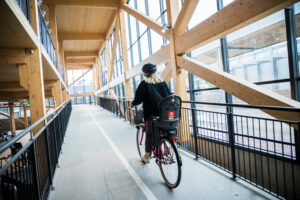Cycling is an efficient way to commute in cities and a key component to advance toward more sustainable transport. In Sweden, a nationwide cycling strategy promotes more and safer cycling.
The Swedish Government has adopted ‘A national cycling strategy for more and safer cycling – contributing to a sustainable society and a high quality of life throughout the country’.

Image by Tina Axelsson/imagebank.sweden.se
Through this strategy, the Government seeks to encourage cycling to reduce traffic congestion as well as the environmental impact of motorized travel in built-up areas, promoting sustainable transport solutions.
The national cycling strategy is the first of its kind and has the overall aim of promoting more and safer cycling. It wants to strengthen positive cycling trends and encourage more people to change their habits and start cycling.
One of the strategy’s important starting points is the cyclists themselves. It recognizes that cyclists are not a homogeneous group with similar travel habits, needs, and circumstances; they are individuals of different ages and at various life stages who use bicycles in different ways and for different purposes.
The strategy focuses on the following:
- more bicycle-friendly municipalities;
- greater knowledge about different groups of cyclists;
- higher priority for bicycle traffic in community planning;
- more demonstration projects;
- more functional and user-friendly cycling infrastructure and adapted management and maintenance;
- and increased physical activity.